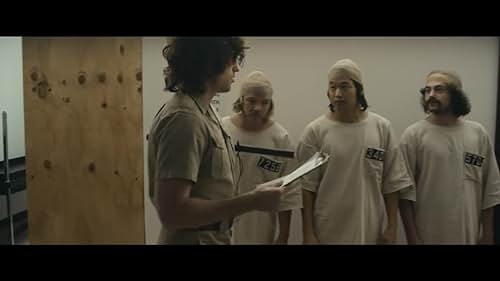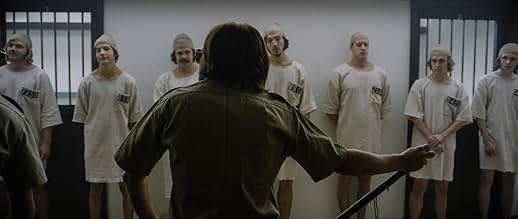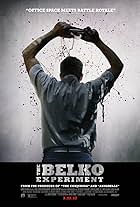NOTE IMDb
6,8/10
47 k
MA NOTE
En 1971, vingt-quatre étudiants, tous masculins, sont choisis pour endosser au hasard les rôles de prisonniers et de gardiens dans une prison fictive située au sous-sol du bâtiment de psycho... Tout lireEn 1971, vingt-quatre étudiants, tous masculins, sont choisis pour endosser au hasard les rôles de prisonniers et de gardiens dans une prison fictive située au sous-sol du bâtiment de psychologie de Stanford.En 1971, vingt-quatre étudiants, tous masculins, sont choisis pour endosser au hasard les rôles de prisonniers et de gardiens dans une prison fictive située au sous-sol du bâtiment de psychologie de Stanford.
- Récompenses
- 4 victoires et 3 nominations au total
Histoire
Le saviez-vous
- AnecdotesAlthough never mentioned in the movie, the real life experiment was funded by the U.S. Office of Naval Research and was of interest to both the U.S. Navy and Marine Corps as an investigation into the causes of conflict between military guards and prisoners.
- GaffesWhen Dr. Zimbardo speaks with his colleague, the colleague says that he will see him at the beginning of the semester. Stanford does not have semesters; rather, it has a quarter academic calendar.
- Citations
Daniel Culp: I know you're a nice guy.
Christopher Archer: So why do you hate me?
Daniel Culp: Because I know what you can become.
Commentaire à la une
This film is a dramatization of a real psychological experiment that took place at the Stanford University in 1971. The motivation was to study the dynamics of individuals who were arbitrarily placed into roles as prisoners and guards at a simulated prison. Since none of the study participants were actual criminals or correction officers, the idea was to glean insight into the psychology of the power imbalance that arises from the situation, as opposed to the people involved.
Things famously degraded quickly and the experiment was terminated after only six days. Multiple guards displayed sadistic traits and performed acts of psychological and even (to a smaller degree) physical torture, all overseen, permitted, and arguably encouraged by "superintendent" Philip Zimbardo, the study's creator.
The conditions the participants were exposed to were reprehensible, but even worse is that ultimately this was simply bad science, making the whole endeavor a cruel waste of time. The experiment lacked much of the basic rigor required, as highlighted in the film by a verbatim repetition of an actual conversation Mr. Zimbardo had with a colleague who questioned some of the basic scientific methodologies being utilized in the study.
Zimbardo himself committed what I would consider borderline criminal acts such as initially denying "prisoner" participants the option to leave when requested (to instill in them the belief that their situation was, in fact, real), which came frighteningly close to converting the "study" into a criminal act of kidnapping in my opinion.
Zimbardo explains this as him getting "to close" to the experiment, but personally I'm not particularly sympathetic to that argument. When you watch the actual clips from the study and read the notes, I'm more inclined to think that Mr. Zambardo himself had a sadistic streak that he failed to control for a time. Honestly, I think the man should have faced criminal charges for his role in this fiasco.
In the end, some good did come out of this experiment in that it created a push for establishing standards and controls for psychological experiments in the future.
Despite knowing the actual outcome, I still felt anxious about the fates of the young men involved, a testament to the power of the acting and directing here. To me, this movie is a chilling and visceral reminder of how easy it is to create conditions that foster cruelty and dehumanization. A rewarding, if somewhat depressing, film to watch.
Things famously degraded quickly and the experiment was terminated after only six days. Multiple guards displayed sadistic traits and performed acts of psychological and even (to a smaller degree) physical torture, all overseen, permitted, and arguably encouraged by "superintendent" Philip Zimbardo, the study's creator.
The conditions the participants were exposed to were reprehensible, but even worse is that ultimately this was simply bad science, making the whole endeavor a cruel waste of time. The experiment lacked much of the basic rigor required, as highlighted in the film by a verbatim repetition of an actual conversation Mr. Zimbardo had with a colleague who questioned some of the basic scientific methodologies being utilized in the study.
Zimbardo himself committed what I would consider borderline criminal acts such as initially denying "prisoner" participants the option to leave when requested (to instill in them the belief that their situation was, in fact, real), which came frighteningly close to converting the "study" into a criminal act of kidnapping in my opinion.
Zimbardo explains this as him getting "to close" to the experiment, but personally I'm not particularly sympathetic to that argument. When you watch the actual clips from the study and read the notes, I'm more inclined to think that Mr. Zambardo himself had a sadistic streak that he failed to control for a time. Honestly, I think the man should have faced criminal charges for his role in this fiasco.
In the end, some good did come out of this experiment in that it created a push for establishing standards and controls for psychological experiments in the future.
Despite knowing the actual outcome, I still felt anxious about the fates of the young men involved, a testament to the power of the acting and directing here. To me, this movie is a chilling and visceral reminder of how easy it is to create conditions that foster cruelty and dehumanization. A rewarding, if somewhat depressing, film to watch.
Meilleurs choix
Connectez-vous pour évaluer et suivre la liste de favoris afin de recevoir des recommandations personnalisées
- How long is The Stanford Prison Experiment?Alimenté par Alexa
Détails
- Date de sortie
- Pays d’origine
- Site officiel
- Langue
- Aussi connu sous le nom de
- Untitled Stanford Prison Experiment Project
- Lieux de tournage
- Sociétés de production
- Voir plus de crédits d'entreprise sur IMDbPro
Box-office
- Montant brut aux États-Unis et au Canada
- 660 561 $US
- Week-end de sortie aux États-Unis et au Canada
- 37 514 $US
- 19 juil. 2015
- Montant brut mondial
- 663 114 $US
- Durée2 heures 2 minutes
- Couleur
- Rapport de forme
- 2.35 : 1
Contribuer à cette page
Suggérer une modification ou ajouter du contenu manquant

Lacune principale
What is the Hindi language plot outline for The Stanford Prison Experiment (2015)?
Répondre





































